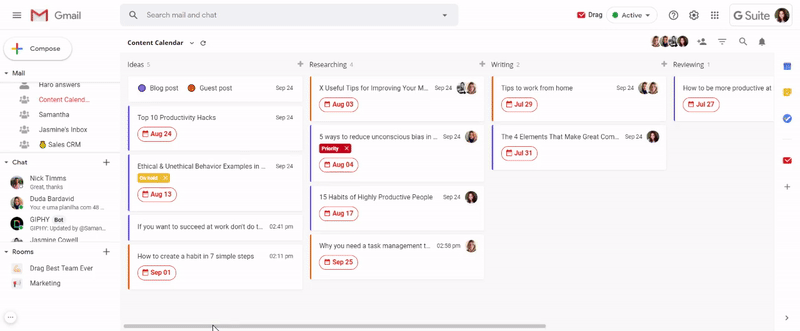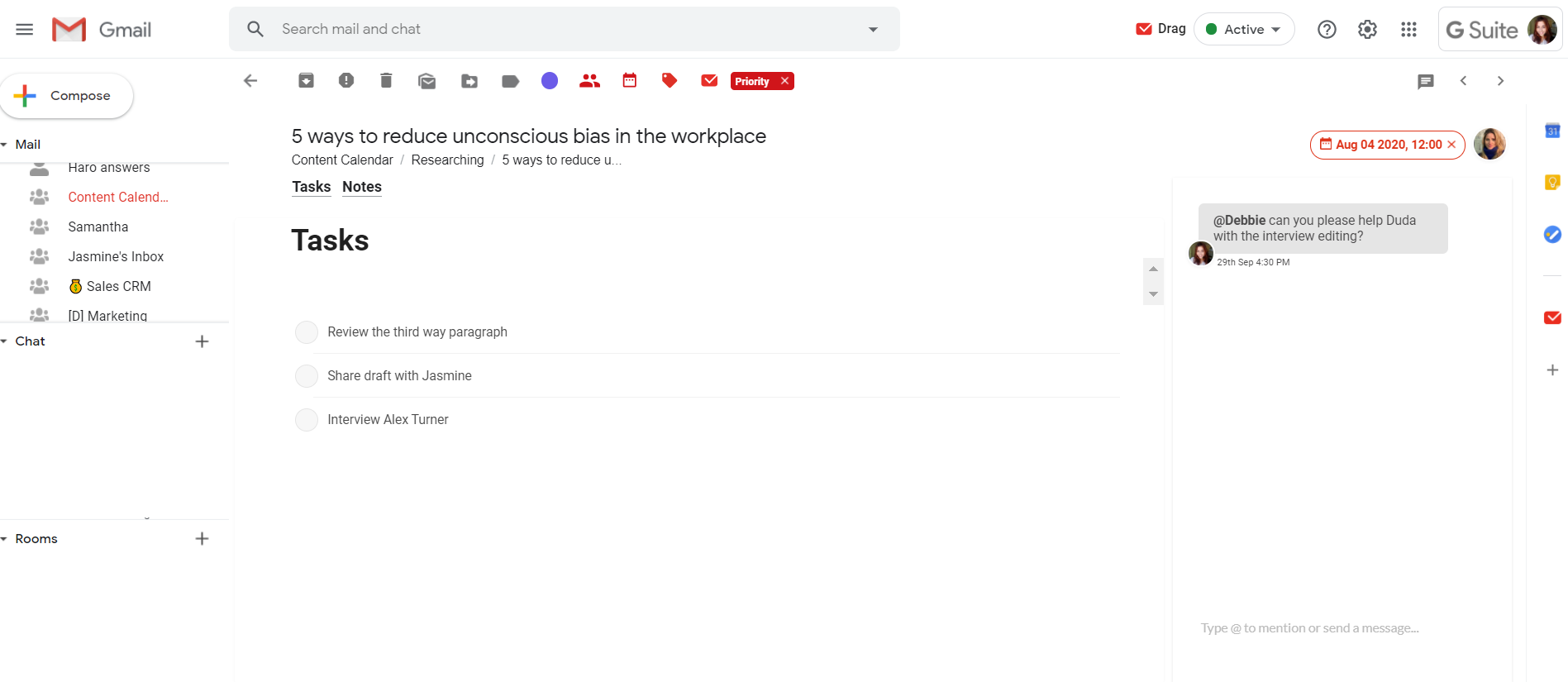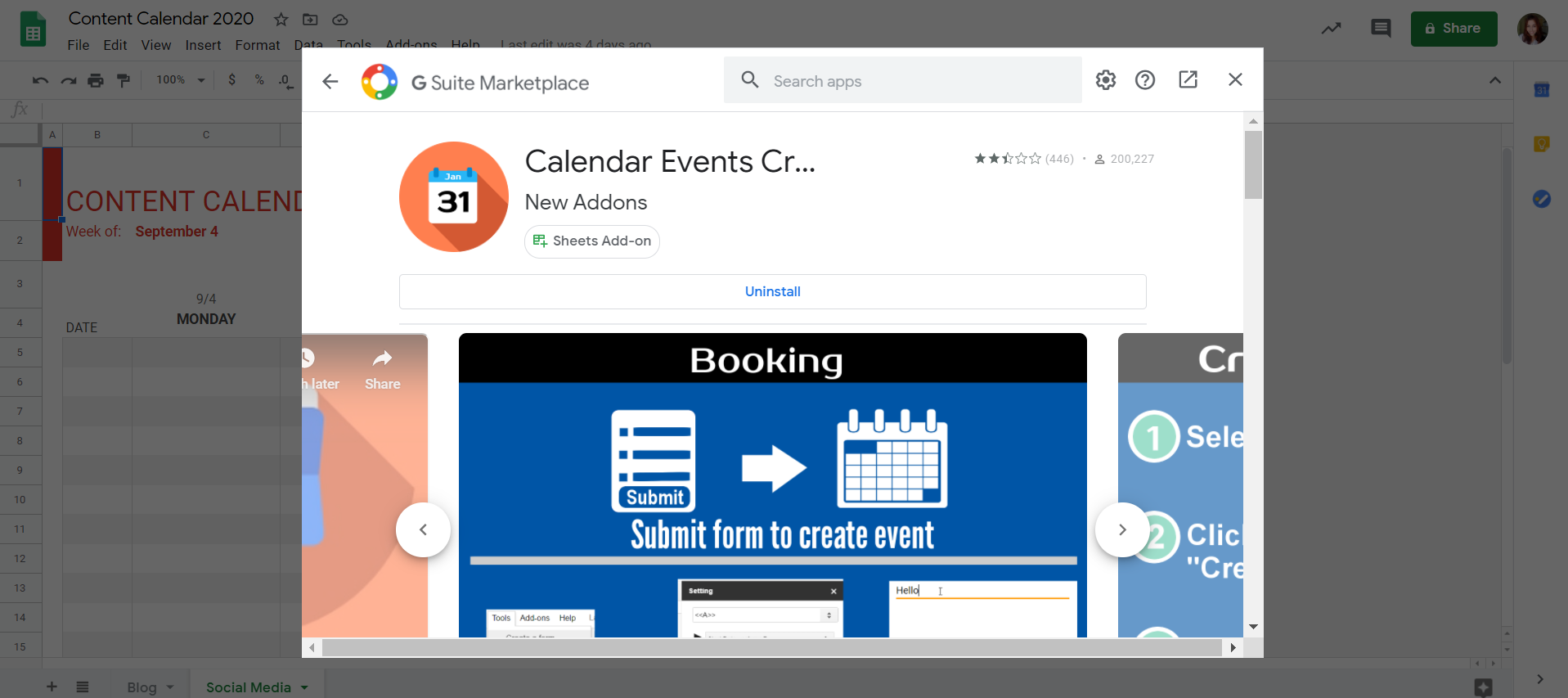
No doubt keeping a content calendar is one of the most important steps of the content strategy. And it needs to be as thorough and collaborative as possible, so no one in a team misses a deadline, and they can keep track of the publications easily.
But what if you could build and run your content calendar from Google Workspace (formerly known as G Suite), using Gmail, Docs, Sheets, and Google Calendar? In fact, it’s totally possible, and you may be using Google Sheets already, but we bet you have no idea how to use Gmail for the same purpose, right?
In this article, you are going to find out why and how to use these apps in your content creation management, as well as examples to help build your new calendar.
What is a content calendar?
A content calendar is where teams manage their entire publishing schedule, usually shared with the whole team. It helps the content team handle the deadlines and also allows them to easily know what each team member is producing at the moment.Having a clear sight of what stage each production is at the moment, keeps the whole team aware of the next steps, besides facilitating to measure the performance and results.Usually, the content calendar has a deadline, specifications about the content links to the publications, and even important attachments.
Why you should build a content calendar using Google Workspace
All of the Google Workspace apps and most of its add-ons have some characteristics in common that are very handy to all kinds of businesses and teams:
- Collaboration in real-time
- Personalization
Let’s check further how your team can benefit from these aspects.
Focus on collaboration in real-time
Collaboration is more than essential for teams. It’s what makes the work happen smoothly, and achieving the results more feasible. That’s why Google Workspace apps are totally focused on it, offering resources for cooperation in real-time.
Highly customizable
As we all know, each team has its own processes and methods of organization. So your experience inside an app needs to be as customizable as possible, to keep the team on the same page without any efforts.
You can use Add-ons on any application inside Google Workspace (For instance, Google Sheets, Gmail, Google Docs, Google Forms). These add-ons allow you to personalize some, if not all, the features you will use to build your Calendar
How to run a content calendar from Google Workspace
There are two best ways of using Google Workspace to run your content calendar:
- Using a spreadsheet in Google Sheets (the most common)
- Using a specific tool that integrates with Gmail – aka Drag.
We will explore each one of these options, and also give you content calendar templates to inspire you when you start building yours.
How to create a content calendar in Gmail
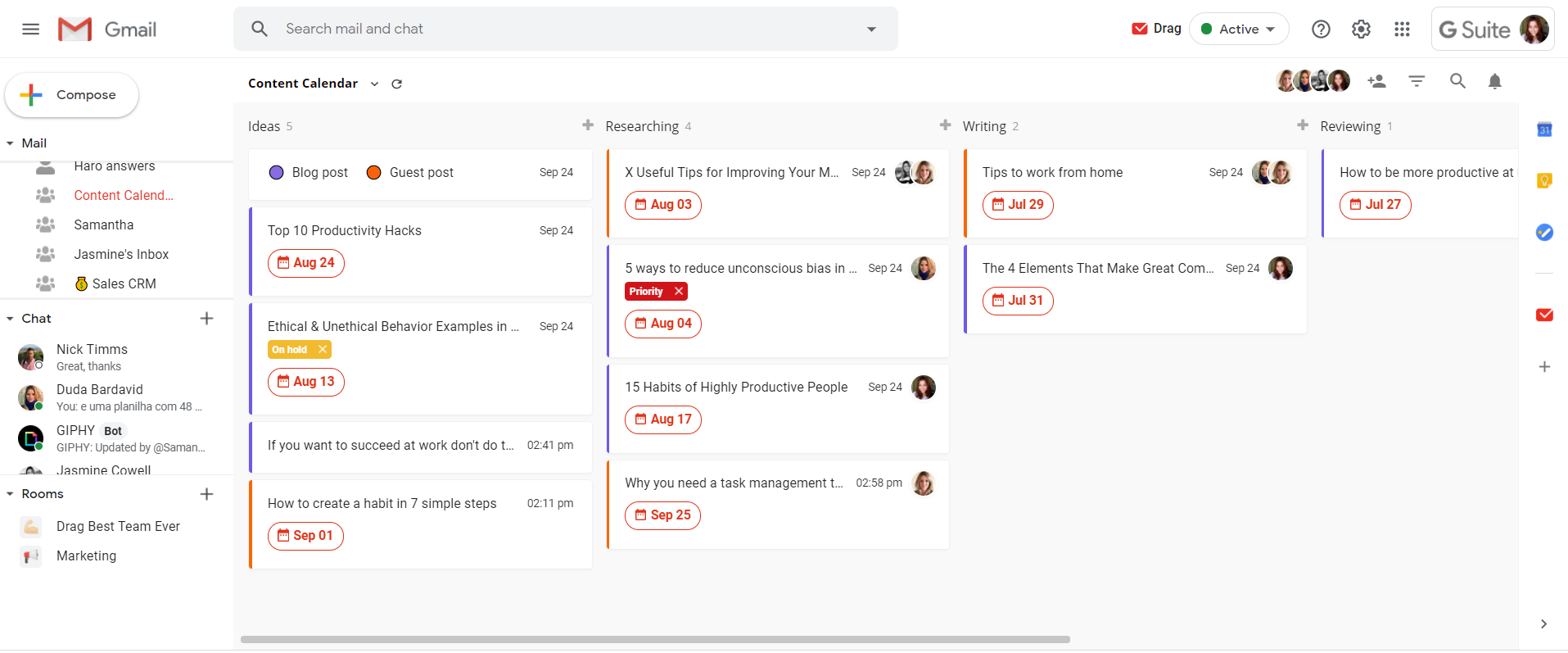
You may be wondering if this is even possible. Using your inbox as a content calendar? And yes, it’s totally doable when you have a tool that integrates with Gmail, and provides all the right features to make it happen.
And Drag is one of these tools that enhance your experience in Gmail, making your inbox perfect for project management. It’s mainly a shared inbox, where you and your team can manage incoming emails to a shared email address. But it also allows you to create tasks from scratch.
You can download Drag and start using it in your inbox now:
After installing Drag, it’s time to create your shared content calendar.
Creating a visual board
The first thing you need to know about Drag is that it works with boards. You can share these boards with your team, as a shared inbox, or just for task management.
These boards have columns that you can rename, but by default are set as to do, doing, and done. The columns represent the stages of your publication workflow.
Inside a board, you can create cards or even add emails, if you chose to share a team inbox (such as sales@ or marketing@). The latter allows you to receive and interact with team emails without leaving your inbox or sharing a team account.
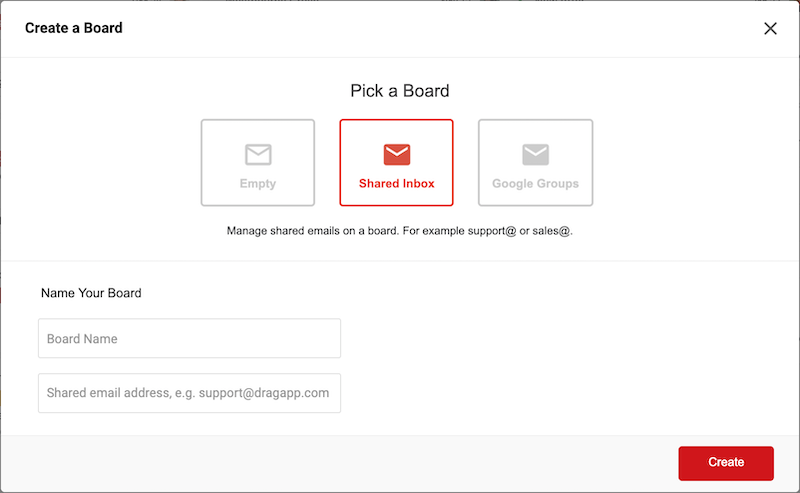
So it depends if you just create topics for the next publications, or if they arrive as emails. You can populate your board with both, if necessary, by dragging the email from your inbox to the board. This way you won’t need to set a shared inbox.
Also, remember that you can either choose between Kanban or list view, to visualize your board. Here’s how the kanban view looks like:
Now, talking about cards: they are full of features. You can add color-coding and tags to them, chat with team members about a specific topic, add due dates, add tasks and notes.
All of these elements make Drag your new visual workflow inside Gmail. It saves time, and effort to understand the tasks and to manage them.
Track your publications
As we said before, each column of your board represents a stage of your content production. In our content calendar example we set the following columns:
- Ideas
- Researching
- Writing
- Reviewing
- Published
But you can edit the columns’ names and put the ones you want at any time.
If you are done with one task, you can drag and drop the card on the next column/stage. This way everyone will be able to know what is happening on the content plan just by looking at it.
Assign tasks
You can easily assign tasks containing future productions to any team member. Just mark the checkbox on the card and click the “people icon” on the top menu. There you will see all the people with whom you share your content calendar. Just click on the person you want to assign to.
They will automatically receive an email notifying them of the new task.
Due dates on Google Calendar
This is a feature that will make your calendar even more functional. Drag has an integration with Google Calendar that allows you to set due dates to all your cards. All these due dates become events on Calendar, to help you never miss a deadline again.
To set a due date, mark the checkbox of the card and click the calendar icon on the top menu. Or just open the card and click the calendar icon. Then choose a date and time on the pop-up.
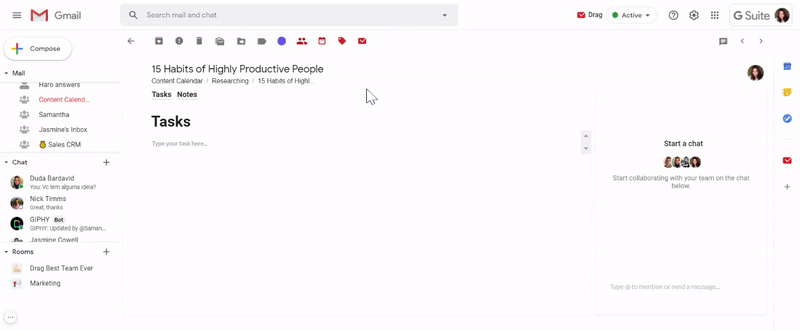
Besides, you can easily visualize your schedule without leaving Gmail. Just go to the right menu bar (the add-ons bar), and click the Calendar icon. There you can open your schedule and manage all the events, inviting people, attributing times, and editing everything you may need.
Bonus: You won’t have to leave your inbox

If you use Gmail for Google Workspace, you can have all the potential of its new home for work. It basically means that in your Gmail inbox, you will be able to have Google Chat, shared tasks, and shared files with your team.
You won’t need to switch tabs between a chat app, your email, a document with content you’re working on, or Drag. And to do that you only need to enable chat to work in Gmail, by clicking the gear icon (settings) > See all setting > Chat and Meet.
Then Chat will appear on the left of your corner, with the section “Rooms”. Create a new room and invite all the members of your team.
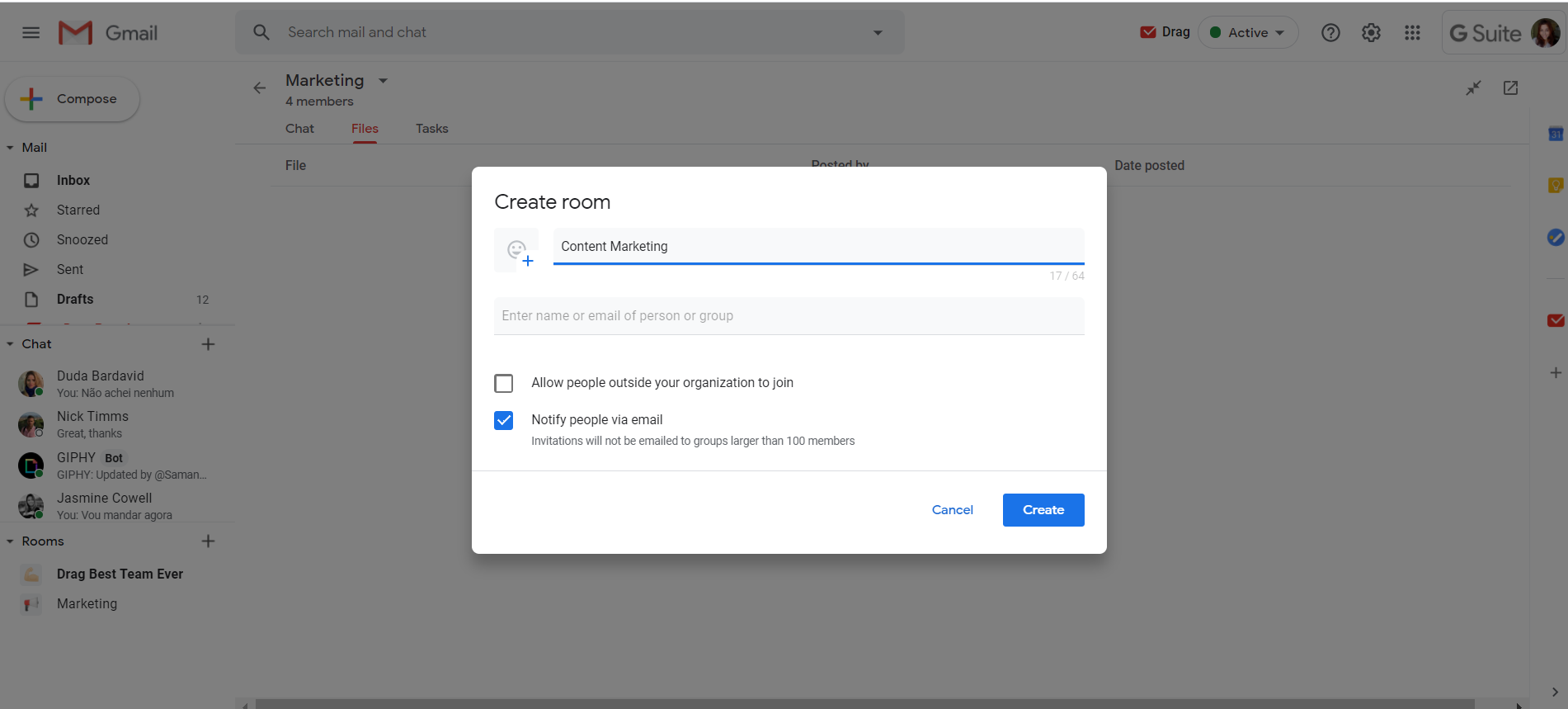
In your new Room, you can chat with teammates and share documents from Docs. Click the tab “Files” and open the document you want to edit with the team. The document will open on the right of your Gmail screen. You can chat with the teammates while you work together in real-time in this file.
How to make a content calendar with Google Sheets
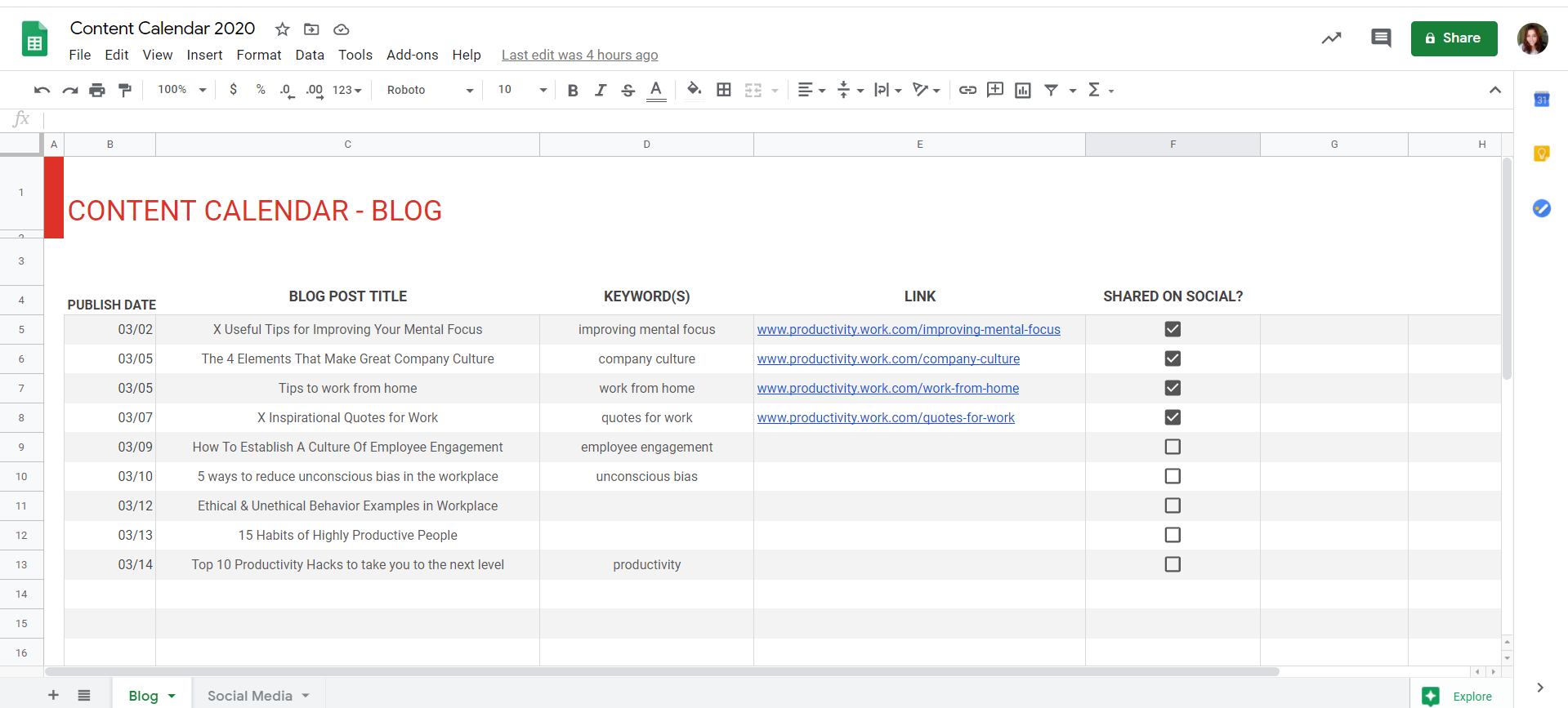
Using Google Sheets is really straightforward, but you can have the most of it if you use advanced options. So we recommend you to read our Google Sheets guide, to understand all of its functionalities:
Google Sheets: The Most Complete Guide
But once you create a spreadsheet, you only need to rename your columns and add lines. The visual of it will be your personal touch, usually with the company’s branding.
Then you can your document with teammates, so they can view and edit it at any time.
Collaborate with your teammates
The comments resource is used a lot when you are editing a spreadsheet at the same time with other teammates. You can add notes, suggestions, or call the attention of a team member to specific cells in the spreadsheet.
They stay in interactive boxes, that appear when you hover the cell, with the name and photo of the person who commented. It’s possible to reply and mention people who have access to the document.
Moreover, with Google Sheets, you can share your spreadsheets with the whole team, so they can view or/and edit it online. Another important feature is that up to 50 people can access and edit spreadsheets at the same time. That’s why it is suitable for both small and big teams.
Use add-ons
Some Add-ons help you build diagrams, change table styles, get data from outside software, and so many other functionalities.
But one in specific can link the dates you set on a spreadsheet to Google Calendar: Calendar Events Creator
To use Calendar Events, select the cell with the date, then go to the top bar menu. Select Add-ons > Calendar Events Creator > Create event(s).
Then your date will be in your Google Calendar schedule, so you can keep up with due dates.
Wrapping up
Whether you choose to use Drag or Google Sheets to run your content calendar, something is inevitable: you’re going to see a huge improvement in your productivity. Both provide collaboration features and can eliminate a considerable amount of time, you would spend switching between tools.
If you already are a Google Workspace user, the alternative of keeping your content management inside of it is costless and effortless.
But if you’re not, how about having a look at its plans and prices? You can be sure that having a business platform like this will turn out to be a big enhancement to your company in general. And your content team will thank you later for reducing so many third-party tools to manage and publish content.
Use Gmail as your new content calendar.
Drag turns Gmail into your Team’s Workspace – One single place to support customers, manage tasks and close deals, from the place teams love: Gmail. We are a Techstars-backed Company, trusted by 30,000 users around the World.


